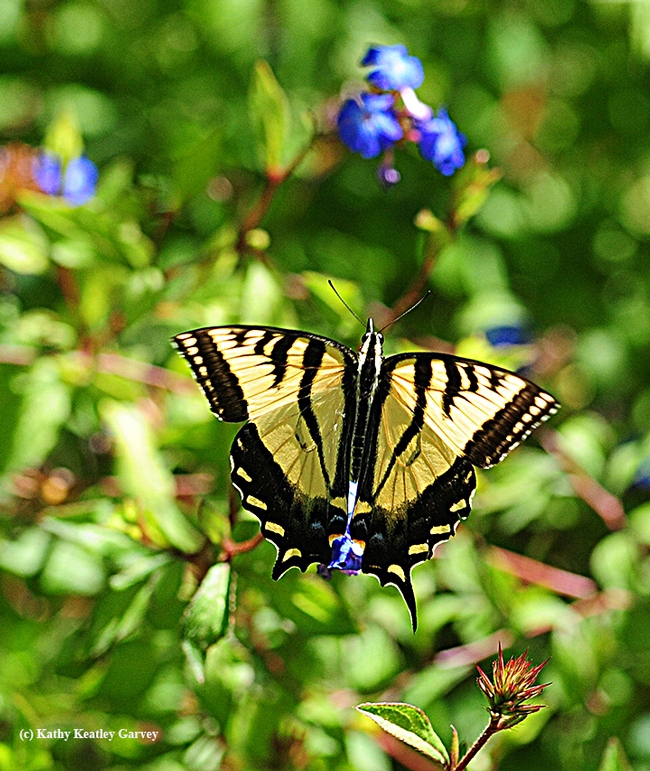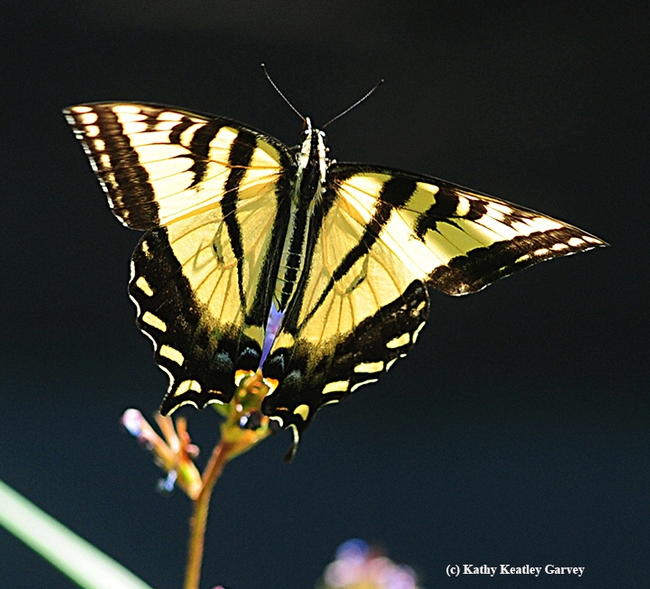When you're chasing a tiger, you don't have to worry about the fangs or the claws.
No worries about this tiger. This tiger has wings.
If you head over to the Storer Garden at the UC Davis Arboretum, you'll see plenty of tigers, Western tiger swallowtail, on the dwarf plumbago, Ceratostigma plumbaginoides. The plumbago is an Arboretum All-Star. (The UC Davis Arboretum horticultural staff has singled out 100 tough, reliable plants as All-Stars; that is, they're "easy to grow, don't need a lot of water, have few problems with pests or diseases, and have outstanding qualities in the garden. Many of them are California native plants and support native birds and insects. Most All-Star plants can be successfully planted and grown throughout California.")
The Western tiger swallowtail (Papilio rutulus) probably would consider the plumbago an All-Star, too, as it flutters around, sipping nectar and looking for a mate.
If you're lucky, you might be able to capture an image of the tiger next to the dwarf plumbago sign. Or, if you're really lucky, you might get two butterflies in one photo.
The Western tiger swallowtail is the kind of butterfly that takes your breath away; you tend to hold your breath while you're trying to hold onto a view of the tiger. It's a bit of flying sunshine in days darkened with trouble and turmoil.
Butterfly guru Art Shapiro, UC Davis distinguished professor of evolution and ecology, writes this about the tiger on his website (he's been monitoring the butterfly populations of Central California for more than 40 years): "The Western Tiger Swallowtail is basically a species of riparian forest, where it glides majestically back and forth along the watercourse. It has expanded into older urban neighborhoods where several of its host genera are grown as shade trees, and behaves as if the street were a watercourse. In the high country and on the Sierran east slope its usual host is Aspen."
Shapiro says the tiger "visits Yerba Santa, California Buckeye, Milkweed, Dogbane, Lilies, Coyotemint" and frequents gardens for Lilac and Buddleia. "Spring individuals are smaller and usually paler than summer. Low-elevation hosts include Sycamore (Platanus), Ash (Fraxinus), Cherry and other stone fruits (Prunus), Willow (Salix), Privet (Ligustrum), Lilac (Syringa) and (in Sacramento County) Sweet Gum (Liquidambar)."
On our block, we've seen the tiger flying around the sycamore and sweet gum. It then flutters over to our pollinator garden to sip nectar from the Buddleia (butterfly bush), Tithonia (Mexican sunflower) and Lantana.
This tiger has wings!
Attached Images:

The Western tiger swallowtail (Papilio rutulus) approaches a plumbago in the Storer Garden, UC Davis Arboretum. (Photo by Kathy Keatley Garvey)

Sign of the times, the nectaring times! The Western tiger swallowtail nectars near the plumbago sign. (Photo by Kathy Keatley Garvey)

What's better than one Western tiger swallowtail? Two of them. (Photo by Kathy Keatley Garvey)

Up, up and away! The Western tiger swallowtail soars above the dwarf plumbago. (Photo by Kathy Keatley Garvey)